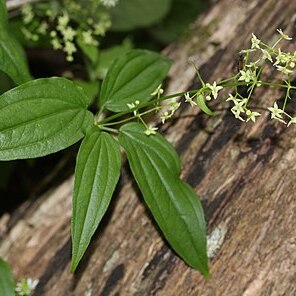Herbs, perennial, rhizomatous; stems erect, to 60 cm tall, solitary or usually grouped, unbranched or few branched, quadrangular, glabrous to pilosulous at least near nodes, ribs rounded, smooth to sparsely scaberulous. Leaves in whorls of 4; petiole (0.3-)0.5-2 cm; blade drying thinly papery, ovate, oblong-ovate, or broadly elliptic, 3-10 × 1.2-4.5 cm, length/ breadth index 1.8-2.3, adaxially subglabrous and scaberulous, abaxially glabrous to pilosulous, base obtuse, rounded, or cordulate, margin scaberulous to ciliate, apex acute or acuminate; principal veins 5 or 7, palmate. Inflorescences thyrsoid, terminal and axillary in upper nodes, paniculate, many flowered, 5-30 cm, glabrous to pilosulous; axes scaberulous to smooth; bracts lanceolate, 1.5-8 mm; pedicels 2-7 mm. Ovary ca. 0.8 mm, smooth to scaberulous. Corolla greenish white, rotate, 3-4 mm in diam., glabrous, with fused base 0.2-0.6 mm; lobes 5, lanceolate, 1.7-2 mm, acute to caudate. Mericarp berry black, ca. 4 mm in diam., smooth. Fl. May-Jul, fr. Sep-Oct.
More
A herb. It keeps growing from year to year. It has rhizomes. It grows 60 cm tall. The stems are angular. The leaves are in rings of 4. They are broadly oval and 3-10 cm long by 1-5 cm wide. The flowering shoots are near the ends of the stems. There are many flowers in a group between 5-30 cm long. They are greenish-white. The fruit is a black berry 4 mm across.

